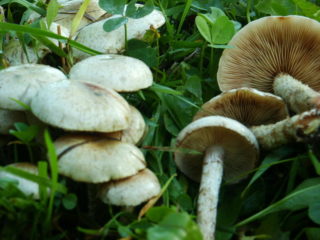Content
Blushing truffle, pinkish rhizopogon, pinkish truffle, Rhizopogon roseolus - these are the names of the same mushroom of the genus Rhizopogon. The fruiting body forms shallow under the top layer of soil. Rarely found, not in demand among mushroom pickers.
Where do pinkish rhizopogons grow?
The rhizopogon mushroom is found under spruce and pine, in mixed forests where oak predominates, and is less common under other deciduous trees. It is located in groups shallow in the soil, covered with leaf or coniferous litter.Only a small portion of ripe specimens appear on the surface, and even then rarely. The growth pattern makes it difficult to harvest and determine the boundaries of the population.
Fruiting is long, harvesting begins in mid-summer. In the middle zone, if the autumn is warm with sufficient rainfall, the last specimens are found in mid-October. The main accumulation of blushing truffle is sought near pine and spruce trees under a coniferous cushion.
What do pinkish rhizopogons look like?
Rhizopogons are not divided into a stem and a cap. The fruit body is uneven, round or tuberous in shape. They grow under the top layer of soil; most often there are only long threads of mycelium on the surface.
Description of the species:
- The diameter of the fruiting body of an adult specimen is 5-6 cm.
- The peridium is first whitish, then yellow with a greenish tint.
- When pressed, the place turns red, and the color also changes after removal from the soil, the peridium oxidizes and turns pink, hence the species name.
- The surface of young specimens is rough and velvety. Ripe mushrooms become smooth.
- The pulp is dense, oily, during ripening it changes color from white to light brown, turning red at the cut site. The inner part of the peridium consists of numerous longitudinal chambers filled with spores.
Is it possible to eat pinkish rhizopogons?
The species is little known and is not widely collected. Belongs to the category of edible mushrooms. There are no substances toxic to humans in the fruiting body. Rhizopogons are consumed only at a young age. Over time, the pulp becomes loose and dry.
Taste qualities of the mushroom Rhizopogon pinkish
The mushroom vaguely resembles a truffle in taste, a delicacy. The pulp is juicy and dense with a pleasant, sweetish taste, but only in young specimens. The smell is weak, barely noticeable. Peridia are used without preliminary processing.
False doubles
The most similar lookalike is the common rhizopogon (Rhizopogon vulgaris).
Externally, the fruiting bodies of the double resemble potato tubers in color and shape. The surface of the peridium is velvety and light olive in color. The pulp is creamy, dense and oily when cut, darkens slightly, and does not turn reddish. The method, time and place of growth are the same among species. A similar mushroom belongs to the fourth group in terms of nutritional value.
Use
Blushing truffles are used without prior soaking and boiling. The pulp is dense, with a pleasant taste, well suited for all processing methods. You can prepare the second and first courses from pinkish rhizopogon. Fruit bodies are suitable for pickling and pickling. Used as an ingredient in salads, you can make pate or mushroom caviar.
Conclusion
Pinkish rhizopogon is a rare mushroom with a mild smell and taste. Belongs to the conditionally edible group. The fruiting body without a cap and stem is round in shape and is completely located in the ground. The main accumulation of rhizopogans is near coniferous trees.











